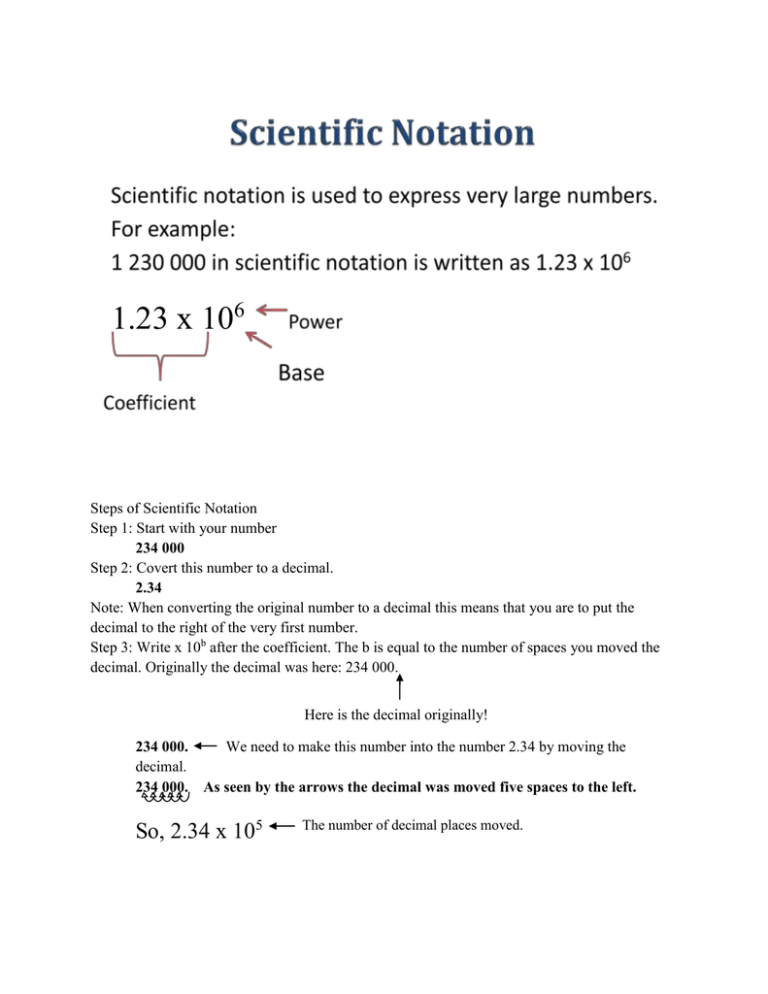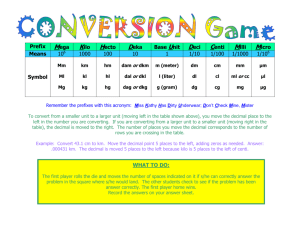
1.23 x 106
Steps of Scientific Notation
Step 1: Start with your number
234 000
Step 2: Covert this number to a decimal.
2.34
Note: When converting the original number to a decimal this means that you are to put the
decimal to the right of the very first number.
Step 3: Write x 10b after the coefficient. The b is equal to the number of spaces you moved the
decimal. Originally the decimal was here: 234 000.
Here is the decimal originally!
234 000.
We need to make this number into the number 2.34 by moving the
decimal.
234 000. As seen by the arrows the decimal was moved five spaces to the left.
So, 2.34 x 105
The number of decimal places moved.
Note: Sometimes you will have to move the decimal from the left to the right instead of
right to left. In this case the power will become negative.
0.0087
Decimal is being moved to the right, so the exponent is going to be negative.
Answer: 8.7 x 10 -3
1345
Decimal is going to be moving to the left, so the exponent is going to be positive.
Answer: 1.345 x 103
Example: 0.053
Step 1: Start with your number 0.053
Step 2: Covert this number to the decimal 5.3
Step 3: Write “x10b” after the decimal number. b = number of times you moved the
decimal.
The exponent is negative because the decimal was moved twice to the right.
5.3 x 10-2
Scientific Notation Worksheet - Solutions
Convert the following numbers into scientific notation:
1) 3,400 3.4 x 103
5) 45.01 4.501 x 101
2) 0.000023 2.3 x 10-5
6) 1,000,000 1 x 106
3) 101,000 1.01 x 105
7) 0.00671 6.71 x 10-3
4) 0.010 1.0 x 10-2
8) 4.50 4.50 x 100
Convert the following numbers into standard notation:
9) 2.30 x 104 23,000
13) 9.11 x 103 9,110
10) 1.76 x 10-3 0.00176
14) 5.40 x 101 54.0
11) 1.901 x 10-7 0.0000001901
15) 1.76 x 100 1.76
12) 8.65 x 10-1 0.865
16) 7.4 x 10-5 0.000074
The Seven Base SI (International System of Units) Units
Base Unit
SI Abbreviation
Kilogram
kg
Meter
m
Mole
mol
Kelvin
K
Second
s
Ampere
A
Candela
cd
What it is Measuring
mass
length/ distance
amount of Substance
temperature
time
electric current
luminous intensity
**These are the seven basic units from which all other units are derived. The metric system is
widely used today. The metric involves measurements such as meters, liters, and grams (THESE
ARE NOT SI NASE UNITS). The Imperial System is also recognized and used in society today..
The Imperial System involves measurements such as inches, pounds and gallons (THESE ARE
NOT SI BASE UNITS).
Moving
to the
left
Prefix
giga
mega
kilo
hecto
deca
deci
centi
milli
micro
nano
pico
In other words…
Symbol
Scientific Notation
G
109
M
106
k
103
h
102
da
101
Base unit [gram (g), meter(m), liter (l), etc.] x100
d
10-1
c
10-2
m
10-3
10-6
μ
n
10-9
p
10-12
Moving
to the
right
Converting Units:
234 cm
m
Step 1: Find the units given in the question on the chart.
234 cm (In bold on the chart)
Prefix
Symbol
Scientific Notation
giga
G
109
mega
M
106
kilo
k
103
Moving
hecto
h
102
deca
da
101
to the
0
Base unit [gram (g), meter(m), liter (l), etc.] x10
left
deci
d
10-1
centi
c
10-2
milli
m
10-3
micro
10-6
μ
nano
n
10-9
pico
p
10-12
Step 2: Find the unit you are converting to on the chart.
- In this example we are converting cm m (Meters is italicized on the above chart).
Step 3: Look at the exponent in the third column. It does not matter if it is positive or negative in
this method of conversion. The exponent is 2 as indicated by the chart. This means the decimal
will be moving two spots.
Step 4: Determine whether you are moving up the chart to get to unit you are converting to, or
down the chart to get to the unit you are converting to. In this case we are moving up which
means we will be moving the decimal two spots to the left (as indicated by the arrow on the
side).
Final Answer: 234cm 2.34 m
Moving
to the
right
Examples:
Convert 12.54 kilometers to centimeters.
How many jumps is it from "kilo-" to "centi-"? Five, to the right.
So I move the decimal point five places to the right, filling in the extra space with zeroes:
You don't have to make a loopy arrow like I did, but the loops help you keep track of the steps
that you're counting, and make it really easy to see where to add the zeroes, if you need to. In
this case, after moving the decimal point and adding the zeroes, I get:
12.54 km = 1 254 000 cm
Convert 457 mL to hL.
Copyright © Elizabeth Stapel 2005-2011 All Rights Reserved
How many jumps is it from "milli-" to "hecto-"? Five, to the left.
So I move the decimal point five places to the left, filling in the empty spots after the decimal point
with zeroes:
Then my answer is:
457 mL = 0.00457 hL
*Note: Not all the units go up by ten. For example, kilo (103) to mega (106).
Extra Questions Solutions
1. Convert each of the following into scientific notation.
a) 3.427 x 103
d) 1.72 x 102
g) 3.1000 x 105
j) 4.55 x 10-5
m) 9.82 x 10-4
p) 3.03 x 10-1
s) 5.65 x 10-3
v) 1.000 x 100 = 1.000
b) 4.56 x 10-3
e) 9.84 x 10-4
h) 1.14 x 102
k) 2.2052 x 103
n) 4.73 x 10-2
q) 2.04 x 106
t) 1.3622052 x 106
c) 1.23453 x 105
f) 5.02 x 10-1
i) 1.072 x 102
l) 3.00 x 10-1
o) 6.50502 x 102
r) 1.29 x 100 = 1.29
u) 4.500 x 105
2. Convert each into decimal form.
a) 15600
d) 0.0056
g) 0.0369
b) 259
e) 0.0000459
h) 0.1369
c) 2.59
f) 0.0000209
3. Express each of the following in standard form.
i) 73690000
j) 69000
a) 5.2 x 103 5200
e) 3.6 x 101 36
b) 9.65 x 10–4 0.000965
f) 6.452 x 102 645.2
c) 8.5 x 10–2 0.085
g) 8.77 x 10–1 0.0877
d) 2.71 x 104 27100
h) 6.4 x 10–3 0.006
4. Express each of the following in scientific notation.
e) 16
1.6x101
b) 0.00053 5.3x10-4
f) 0.0043
4.3x10-3
c) 250 2.5x102
g) 0.875
8.75x10-1
a) 78,000
d) 2,687
5. a) 77.1
b) 0.000234
c) 2.90 x 1021
7.8x104
2.687x103
h) 0.012654 1.2654x10-2
d) 6.30 x 106
e) 10.2



